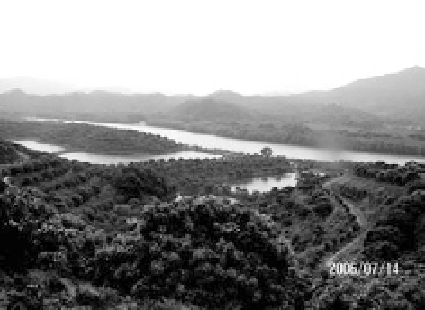Environmental Engineering Reference
In-Depth Information
mitigate the impact. The middle and lower reaches of the Yangtze River is a complex ecosystem with
thousands of lakes and wetlands by the river. Naturally these lakes connected with the Yangtze River and
formed a huge habitat in the past. Humans cut the connection for flood defense (i.e. levee construction)
and aquatic farming, thus, fragmenting the habitat. Relinkage of the lakes and wetlands with the river
will be an important restoration strategy for the ecosystem.
(a) (b)
Fig. 11.13
(a) Concrete banks and bed of an urban channel in Beijing result in the disappediance of many species;
and (b) a river-linked wetland by the Zengjiang River
Principle
ĕ
—Restoring Natural Landscapes
River flows through the continent and shapes all landscapes. Various river uses have changed the landscapes.
Beautiful meanders have been changed into straight channels with hardened banks, waterfalls have been
replaced by power stations, and the riparian forests have been changed into grand levees. Recently, people
have realized that the landscapes are a wealth of nature presented to humans. Landscape restoration has
become a public concern and projects have been performed to restore landscapes.
Cheongyechon in Seoul, South Korea was a beautiful stream in the past. Following rapid urbanization
in the drainage area the river was clogged with rubbish and reshaped into a underground culvert. To
restore the riverscape the government invested 360 million to reconstruct the urban stream. As shown in
Fig. 11.14(a), now Cheongyechon has become a resort for urban residents, with clean water, a beautiful
artificial step-pool system, bridges, riparian vegetation, and pedestrian paths, making the city more
charming (Kyung and Zeng, 2007).
Jiuzhai Creek in southwestern China was a debris flow gully in the past. Landscape protection and
restoration projects have been carried out. Check dams have been constructed to control debris flows but
not affect the landscapes. The ecosystem in the creek has a high ecological resilience, which has been
considered as an important element in the projects (Cui et al., 2003). Figure 11.14(b) shows the beautiful
water falls on Jiuzhai Creek. The landscapes in the creek attract 1.5 million tourists every year. Economically,
Jiuzhai Creek with its preserved landscapes is a better money-maker than hydro-power development. The
annual tourism income is several times the hydro-power income from the Sanmenxia Dam on the Yellow
River.
11.1.4 Limit Velocity Law
There is a noticeable phenomenon in natural streams: the flow velocity varies in a limited range,
generally from zero to 2.5 m/s, while the discharge varies in a range of several orders, of magnitude from
zero to thousands or several tens of thousands of m
3
/s, depending on the size of the river. In alluvial


Search WWH ::

Custom Search